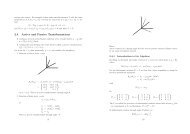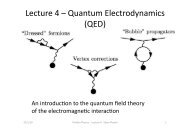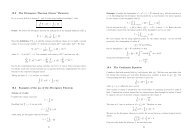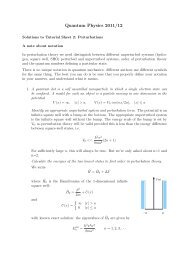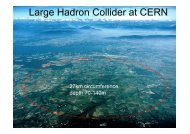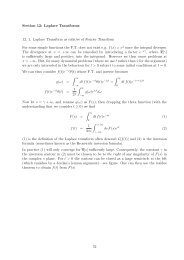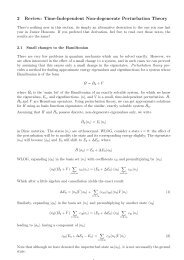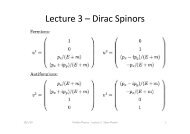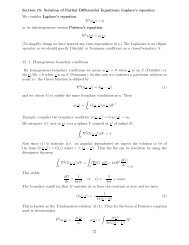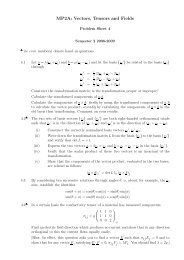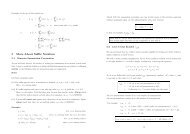Tutorial 1: SubAtomicPhysics: Nuclear Physics
Tutorial 1: SubAtomicPhysics: Nuclear Physics
Tutorial 1: SubAtomicPhysics: Nuclear Physics
Create successful ePaper yourself
Turn your PDF publications into a flip-book with our unique Google optimized e-Paper software.
7. The atomic mass of a nucleus is predicted by the semi-empirical mass formula to be given byM(N,Z)c 2 = ZM H c 2 + NM n c 2 - a v A + a s A 2/3 + a c Z 2 /A 1/3 + a sym (N-Z) 2 /A + δWhere M H = 938.8 MeV/c 2 , M n = 939.6 MeV/c 2 , a v = 15.8 MeV, a s = 18.0 MeV, a c = 0.7 MeV anda sym = 25.3 MeV.Mirror nuclei are nuclei with the same mass number A and interchanged values of N and Z. Whichterms in the above formula give rise to differences in atomic mass between a pair of mirror nuclei?Calculate the predicted atomic mass difference between 11 C(Z=6) and 11 B(Z=5) in units of MeV/c 2 .From this information and any general considerations, what can you deduce about the possible decaymodes for these two nuclei?Mirror nuclei have the same value of A but interchanged values for N,Z. The only terms in the SEMF which survive when takingthe mass difference between mirror nuclei is the ZM Hc 2 , NM nc 2 and a cZ 2 /A 1/3 .∆Mc 2 = M( 11 B)-M( 11 C) = (Z 1 -Z 2 )M H c 2 + (N 1 -N 2 )M n c 2 + a c /A 1/3 (Z 1 2 -Z 2 2 )Using given values of Z aand masses gives ∆Mc 2 ) = -2.66 MeVDifference shows 11 B more stable than 11 C.11 C will decay to 11 B by β + emission8. In the semi-empirical mass formula what experimental evidence does the pairing term δ account for?For a given value of the mass number A, nuclear masses can be expressed as a quadratic function inZ. Using the “minimum isobar” formula (as derived in the lecture notes) determine whether the142 Xe(Z=54) is β + or β - unstable.Pairing term accounts for the observational evidence that even-even nuclei are more stable than odd-odd nuclei. It has a quantummechanical origin and reflects the extra binding felt by paired nucleons (with opposite spins) which can share the same spatialstates, increasing their probability to be in close proximity to each other and feel the strong force.From formula derived in the notes Z stable = 142 / 1.972 + 0.015(142) 2/3 = 60Therefore 142 Xe(Z=54) will decay by β - towards the stable nucleus at Z=60<strong>Tutorial</strong> 3:<strong>SubAtomic<strong>Physics</strong></strong>: <strong>Nuclear</strong> <strong>Physics</strong>1) A neutron star can be crudely approximated as a large assembly (>~10 55 ) of neutrons. Use the semiempirical mass formula to estimate the binding energy per nucleon of a neutron star (you mayneglect the δ term). Comment on the physical implications of the value obtained.Which additional term should also be included in the mass formula if it is to be extrapolated toneutron stars? Propose a form for this extra term.Yhe expression for the binding energy per nucleon (note you get this by dividing the formula for the binding energy (B) given inthe notes by A!!)B/A = a v – a s A -1/3 – a c Z 2 /A 4/3 –a s (A-2Z) 2 /A 2As A is very large the surface and coulomb terms are negligible. The B/A is determined by the difference between the volumeterm and the asymmetry term. The latter approaches if we assume the star is dominantly neutrons i.e. A>>ZB/A = a v - a s = 15.6 – 23.3 MeV = -7.7 MeV. The expression is negative implying the system is unbound. Therefore to bind a starother forces contribute. For a large object such as this the gravitational effects cannot be neglected. An attractive gravitationalpotential energy term should be added to the SEMF. The form will be similar to the derivation of the coulomb potential term inthe lectures. i.e. (3/5) (G/r o ) (M 2 /A 1/3 ). Using this term you can go on to calculate the minimum size needed for a stable star !!2) Use the semi empirical mass formula to calculate the energy released when 238 U fissionssymmetrically. Propose why fission products are often unstable.



